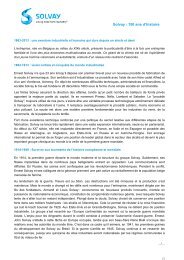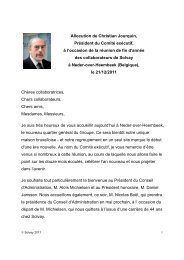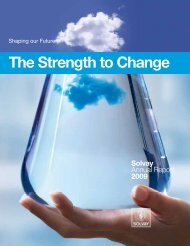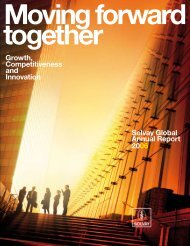THE FUTURE, - Solvay
THE FUTURE, - Solvay
THE FUTURE, - Solvay
Create successful ePaper yourself
Turn your PDF publications into a flip-book with our unique Google optimized e-Paper software.
Performance<br />
improvement<br />
34<br />
Performance improvement > INNOVATIONS 09<br />
209784 209805 209806<br />
NEW EFFICIENT CROSS-FLOW FILTRATION<br />
PROJECT<br />
Two-in-one wash<br />
<strong>THE</strong> PROJECT. A key phase in the<br />
hydrogenation stage of the hydrogen peroxide<br />
manufacturing process is the separation of the<br />
catalyst from the reaction mixture.<br />
The system currently in use, consisting of direct<br />
fi ltration and then washing the fi lter cake with a<br />
reverse fl ow, dates from the 50s and the many<br />
improvements made over time have reached their<br />
limits in terms of effi ciency. This system is not<br />
feasible in the giant installations of the future<br />
(beyond the current 330 Ktons). Effi ciency is lost<br />
due to the mechanical wear of the catalyst, and<br />
power consumption is much too high due to the<br />
reverse fl ow.<br />
In the new cross-fl ow system, through the use of<br />
tangential forces the catalyst is washed<br />
simultaneously with the fi ltration operation, and<br />
then returned to the reactor.<br />
This idea from the 90s has been developed only<br />
recently. A pilot plant built in Povoa (Portugal) in<br />
2008 has enabled us to test and optimize the<br />
operating parameters for a larger installation. These<br />
were then applied at Curitiba (Brazil) over an<br />
11 month period in order to carefully study all the<br />
hydrodynamic phenomena and defi ne the<br />
parameters for a 160 Ktons/year unit.<br />
This original process has shown its full savings<br />
potential in terms of energy, materials (less catalyst<br />
losses from wear), labour and maintenance.<br />
It is also opening the way to even larger units<br />
than the biggest ones built until now, i.e. above<br />
400 Ktons/year.<br />
SBU PEROXIDES/BELGIUM<br />
> Jal Dadabhoy; Pedro Borges; Patrick Dhaese;<br />
Massimo Fedeli; Cesar Muller; Gustavo Nakamura.<br />
RECRUIT & REWARD<br />
Looking for our future<br />
colleagues<br />
<strong>THE</strong> PROJECT. To continue the growth of<br />
<strong>Solvay</strong> Biologicals BV in the Netherlands in a very<br />
diffi cult employment market, the company needed<br />
to fi nd creative and innovative ways to fi ll its<br />
vacant positions.<br />
To address the problem, we recognized and made<br />
use of the fact that by far the best ambassadors<br />
<strong>Solvay</strong> has are its own employees.<br />
We introduced a pioneering scheme whereby we<br />
asked our employees to actively introduce us to<br />
possible new colleagues. If they introduced a<br />
candidate who successfully fi lled an open<br />
vacancy, they would receive a EUR 1 500 reward.<br />
This strategy could easily be replicated at other<br />
<strong>Solvay</strong> sites.<br />
PHARMACEUTICALS SECTOR<br />
> Françoise Jeuken; Marvin Beusekamp;<br />
Hannelore Kornet; Judith Kruit; Anja Oudshoorn.<br />
CLINICAL TRIAL SUPPLY: COMPUTER<br />
SIMULATIONS REDUCE WASTE AND SAVE<br />
MILLIONS<br />
Stop over-production!<br />
<strong>THE</strong> PROJECT. Until recently, to avoid<br />
interruption of clinical trials due to depleted study<br />
medication stocks, over-production of trial<br />
supplies was normal. This represented not only<br />
a waste of compound, but a waste of time in<br />
production of the active pharmaceutical<br />
ingredient, formulation, packaging, storage,<br />
distribution and at the end of the study<br />
reconciliation and destruction of unused<br />
medication supplies, all of which had a signifi cant<br />
impact on environment, budget and resources.<br />
Now for each trial different computer simulations<br />
are used to calculate the safe minimum amount<br />
of compound required, integrating a level of<br />
acceptable risk which reduces the overage<br />
(excess) of compound produced for each study.<br />
Proven advantages in terms of clinical trials<br />
include shorter lead times, quicker<br />
commencement of clinical trials, and increased<br />
satisfaction at clinical trial sites.<br />
PHARMACEUTICALS SECTOR<br />
> Geurt-Paul Koning; Marina Romay;<br />
Henk Teunissen; Ad Theeuwes; Philippa Tibbits;<br />
Serge VandeWitte; Erik Vanleeuwen; Isabel White.


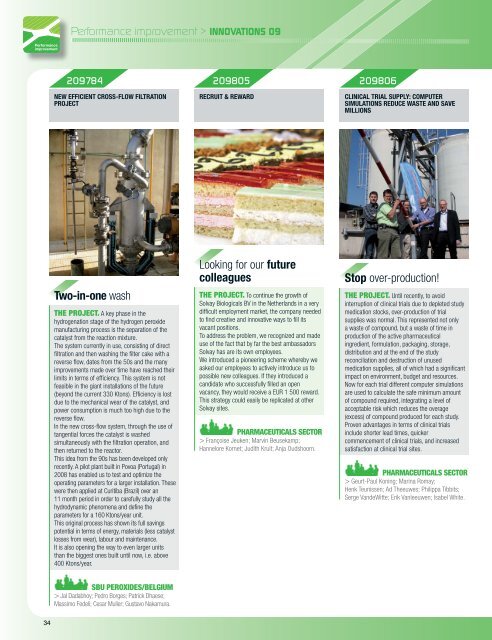

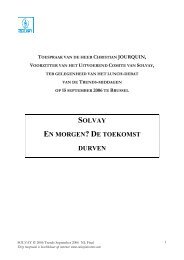
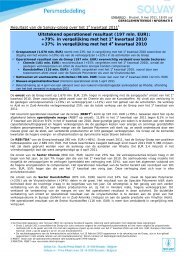

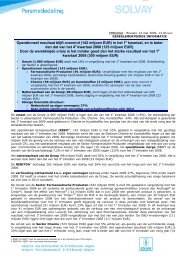
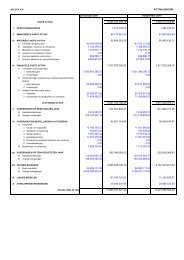

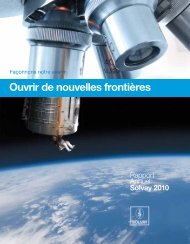
![PROC.1 [LETTRE] - Solvay](https://img.yumpu.com/16585746/1/184x260/proc1-lettre-solvay.jpg?quality=85)
